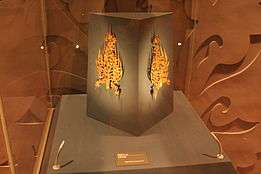501
This article is about the year 501. For other uses, see 501 (disambiguation).
| Millennium: | 1st millennium |
|---|---|
| Centuries: | 5th century · 6th century · 7th century |
| Decades: | 470s · 480s · 490s · 500s · 510s · 520s · 530s |
| Years: | 498 · 499 · 500 · 501 · 502 · 503 · 504 |
| 501 by topic | |
| Politics | |
| State leaders – Sovereign states | |
| Birth and death categories | |
| Births – Deaths | |
| Establishment and disestablishment categories | |
| Establishments – Disestablishments | |
| Gregorian calendar | 501 DI |
| Ab urbe condita | 1254 |
| Assyrian calendar | 5251 |
| Bengali calendar | −92 |
| Berber calendar | 1451 |
| Buddhist calendar | 1045 |
| Burmese calendar | −137 |
| Byzantine calendar | 6009–6010 |
| Chinese calendar | 庚辰年 (Metal Dragon) 3197 or 3137 — to — 辛巳年 (Metal Snake) 3198 or 3138 |
| Coptic calendar | 217–218 |
| Discordian calendar | 1667 |
| Ethiopian calendar | 493–494 |
| Hebrew calendar | 4261–4262 |
| Hindu calendars | |
| - Vikram Samvat | 557–558 |
| - Shaka Samvat | 422–423 |
| - Kali Yuga | 3601–3602 |
| Holocene calendar | 10501 |
| Iranian calendar | 121 BP – 120 BP |
| Islamic calendar | 125 BH – 124 BH |
| Javanese calendar | 387–388 |
| Julian calendar | 501 DI |
| Korean calendar | 2834 |
| Minguo calendar | 1411 before ROC 民前1411年 |
| Nanakshahi calendar | −967 |
| Seleucid era | 812/813 AG |
| Thai solar calendar | 1043–1044 |
| Wikimedia Commons has media related to 501. |
Year 501 (DI) was a common year starting on Monday (link will display the full calendar) of the Julian calendar. At the time, it was known as the Year of the Consulship of Avienus and Pompeius (or, less frequently, year 1254 Ab urbe condita). The denomination 501 for this year has been used since the early medieval period, when the Anno Domini calendar era became the prevalent method in Europe for naming years.
Events
By place
Britannia
- Domangart Réti succeeds his father Fergus Mór, after he dies during a campaign against the Picts. He becomes the new king of Dál Riata (modern Scotland) (according to the Annals of Tigernach).
Europe
- King Gundobad breaks his promise of tribute and regains his military power. He besieges his brother Godegisel at the city of Vienne (Burgundy), and murders him in an Arian church along with the bishop. [1]
Asia
- Dong Hun Hou is killed during a siege of the capital Jiankang. He is succeeded by his brother Qi He Di, who becomes emperor of Southern Qi (China).
- Muryeong becomes king of Baekje (Korea). During his reign, the kingdom remains allied with Silla and expands its relationships with China and Japan.
Mesoamerica
- The Maya are peaking in economic prosperity. The civilization at Teotihuacan begins to decline and its people are migrating to the greatest Mayan city, Tikal, bringing with them ideas about weaponry and new ritual practices.
- June 5 – Ahkal Mo' Naab' I comes to power in the Maya city of Palenque (Mexico).
By topic
Medicine
- The Sushruta Samhita medical book becomes a classic of medicine in India. The book contains descriptions of surgery, illnesses, medicinal plants, and a detailed study on anatomy (approximate date).
Religion
- Pope Symmachus, accused of various crimes by secular authorities who support an ecclesiastical opponent, asserts that the secular ruler has no jurisdiction over him. A synod held in 502 will confirm that view.
Births
- Lou Zhaojun, empress dowager of Northern Qi (d. 562)
- Xiao Tong, crown prince of the Liang Dynasty (d. 531)
Deaths
- April 25 – Rusticus, archbishop of Lyon
- Dongseong, king of Baekje (Korea)
- Fergus Mór, king of Dál Riata (Scotland)
- Godegisel, king of the Burgundians
- Pan Yunu, concubine of Xiao Baojuan
- Ravina II, Jewish Talmudist and rabbi
- Su Xiaoxiao, Chinese courtesan and poet
- Xiao Baojuan, emperor of Southern Qi (b. 483)
References
- ↑ Gregory of Tours, History, 2.33
This article is issued from Wikipedia - version of the 9/28/2016. The text is available under the Creative Commons Attribution/Share Alike but additional terms may apply for the media files.
